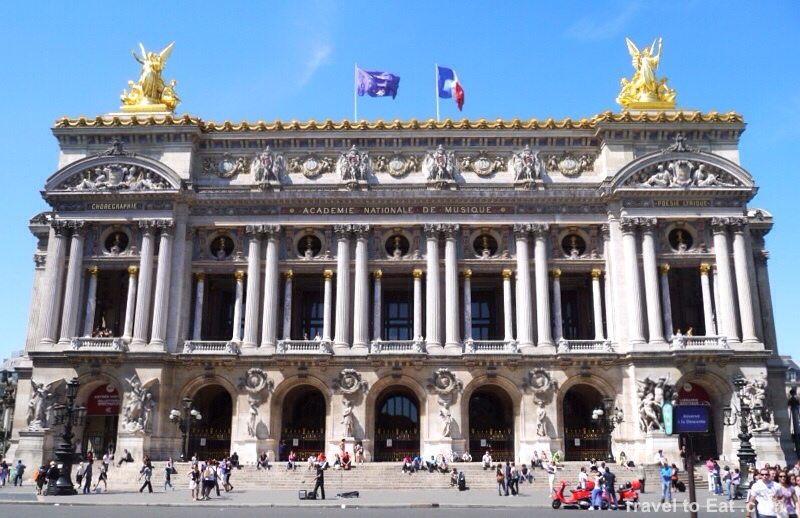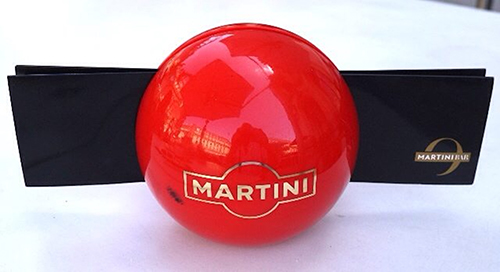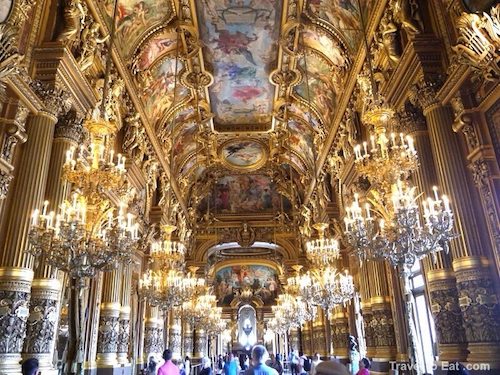
The Palais Garnier is probably the most famous opera house in the world, a symbol of Paris like Notre Dame cathedral, the Louvre, or the Eiffel tower. It is an elegant 1,979-seat opera house, which was built from 1861 to 1875 by Napoleon III for the Paris Opera. This is the thirteenth building to house the Paris Opera since it's founding in 1669 by Louis IV. The Opera has now relocated to L’Opera de la Bastille as of 1989 and the Garnier is used mostly for ballet. The new opera house has had some issues with appearance and acoustics but both “opera houses” are sold out for every performance.
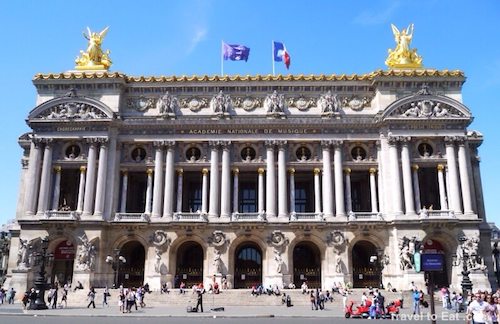
The selection of the architect was the subject of an architectural design competition in 1861, a competition which was won by the architect Charles Garnier (1825–1898).
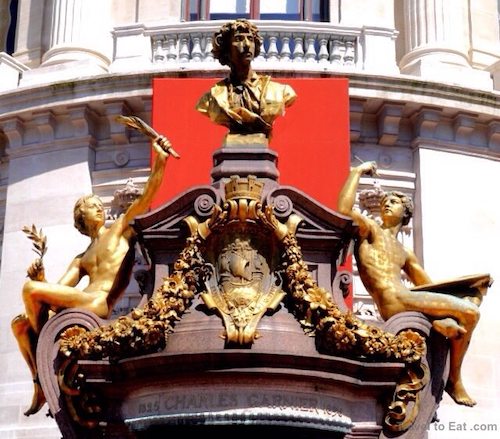
Legend has it that the Emperor's wife, the Empress Eugénie, who was likely irritated that her own favored candidate, Viollet-le-Duc, had not been selected, asked the relatively unknown Garnier: “What is this? It's not a style; it's neither Louis Quatorze, nor Louis Quinze, nor Louis Seize!” “Why Madame, it's Napoléon Trois” replied Garnier “and you're complaining!” Construction was interrupted after the fall of Napoleon III but completed when the preceding opera house, Salle Le Peletier, burned down in 1873.
Andrew Ayers wrote that the judges of the competition in particular admired Garnier's design for “the clarity of his plan, which was a brilliant example of the beaux-arts design methods in which both he and they were thoroughly versed.”

Undoubtedly, the most well-known piece of sculpture associated with the Opéra is The Dance by Jean-Baptiste Carpeaux seen above right. Garnier unveiled the facade sculptures in July, 1869 and The Dance caused an immediate public outcry. People accused the work of indecency and poor taste. The naturalism of the drawing and modeling made the girls look too much like ordinary people. Idealized figures were nude; natural figures were naked.

The linear frieze was redesigned per Napleon III, with alternating low- and high-relief decorative medallions bearing the gilded letters from the imperial monogram (“N” for Napoléon, “E” for Empereur). The custom-designed letters were not ready in time for the unveiling and were replaced with commercially available substitutes. After the fall of the empire in 1870, Garnier was relieved to be able to remove them from the medallions. Letters in Garnier's original design were finally installed during the restoration of the building in 2000 (but not guilded). The original name was “ACADEMIE IMPERIALE DE MUSIQUE”. When the emperor was deposed the Opera was renamed Théâtre National de l'Opéra, a name it kept until 1939. In spite of this, when it came time to change the name on the new opera house, only the first six letters of the word IMPERIALE were replaced, giving the now famous “ACADEMIE NATIONALE DE MUSIQUE”. Bronze busts of many of the great composers are located between the columns of the theatre's front façade and depict from left to right: Rossini, Auber, Beethoven, Mozart, Spontini, Meyerbeer, and Halévy.
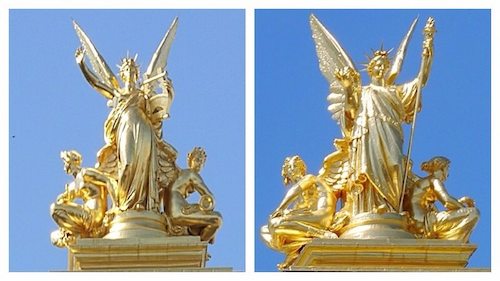
Charles-Alphonse Guméry's gilded bronze sculptural groups Harmony and Poetry were installed in 1869.
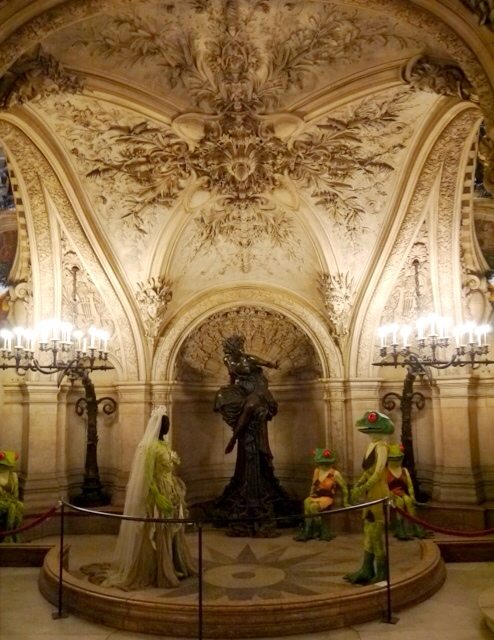
When you first enter by the visitors entrance, you are met by this unlikely tableaux. I don't know what the frogs are doing here but the ceiling and sculpture are gorgeous. This level was the entrance for the help, since this level does not have access to even orchestra seating, the attention of Garnier to even this level gives a taste of things to come on the upper levels. The interior of the Opéra is profusely adorned with sculpture, both decorative and free standing. There are over 75 portrait busts throughout the building and the decorative sculptures are almost innumerable.
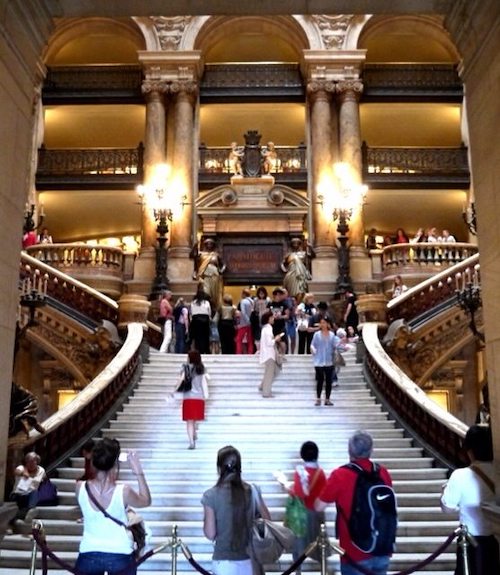
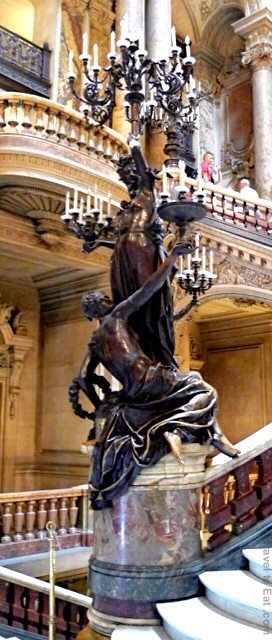
You go up some stairs to the first floor and come upon the grand staircase. As you go up the stairway, you come to the entrances to the auditorium of the Opera.
The Grand Staircase is the compositional heart of the Opéra. All traffic is channeled through the various vestibules and hallways into the majestic stairwell. Theatergoers must ascend the staircase to enter the Auditorium, and Garnier designed the stairs and surrounding cage of pillars and balconies as a major architectural and decorative statement that would “contribute to the general beauty of the building”. On the bottom pedestal of the Grand Staircase railings are radiant, polished copper figures by Albert-Ernest-Carrier-Belleuse. They hold aloft lamps and are crowned with a wreath of lights.
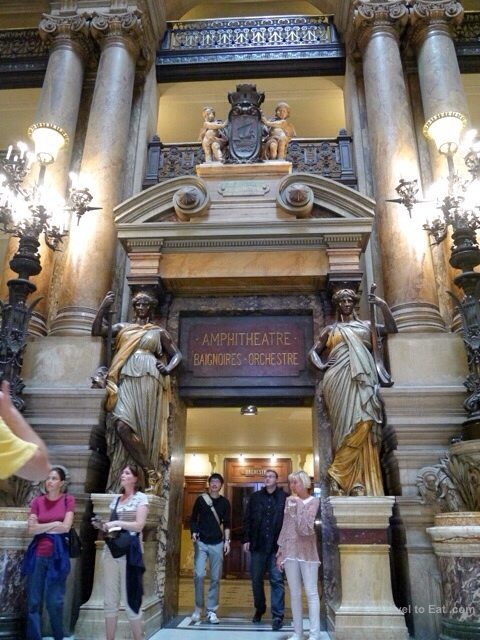
Orchestra seating is one level up while box seats are up two levels. On the landing above and beyond Belleuse’s torchères is the Portal of the Caryatids by Jules Thomas. The exquisite figures, representing Tragedy and Comedy, are executed in six types of colored marble.

Above the grand stairway is a painted ceiling with a square oculus (picture courtesy of The Paris Opéra: Charles Garnier’s Opulent Architectural Masterpiece by Stephen Gjertson). This was done by the painter Isidore-Alexandre Pils depicting: The Triumph of Apollo, The Enchantment of Music Deploying its Charms, Minerva Fighting Brutality Watched by the Gods of Olympus and the rather self-serving The City of Paris Receiving the Plan of the New Opéra.

The 7-ton bronze and crystal chandelier was designed by Garnier. The use of a central chandelier aroused controversy, and it was criticized for obstructing views of the stage by patrons in the fourth level boxes. Originally the chandelier was raised up through the ceiling into the cupola over the auditorium for cleaning, but now it is lowered as seen above. The space in the cupola was used in the 1960s for opera rehearsals, and in the 1980s was remodeled into two floors of dance rehearsal space.
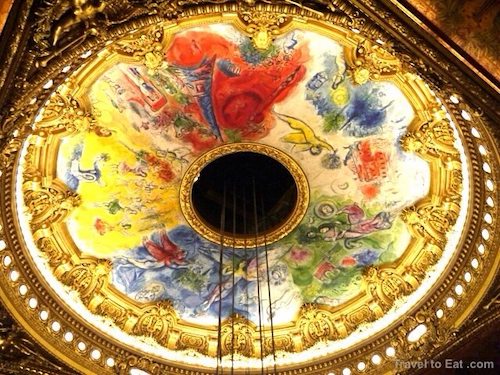
The ceiling area, which surrounds the chandelier, contains a new 1964 painting by Marc Chagall which was installed on a removable frame over the original and depicts scenes from operas by 14 composers – Moussorgsky, Mozart, Wagner, Berlioz, Rameau, Debussy, Ravel, Stravinsky, Tchaikovsky, Adam, Bizet, Verdi, Beethoven, and Gluck. Not everyone loves the painting, personally I have always loved Chagall and this touch reminds me of the Metropolitan Opera House in New York.
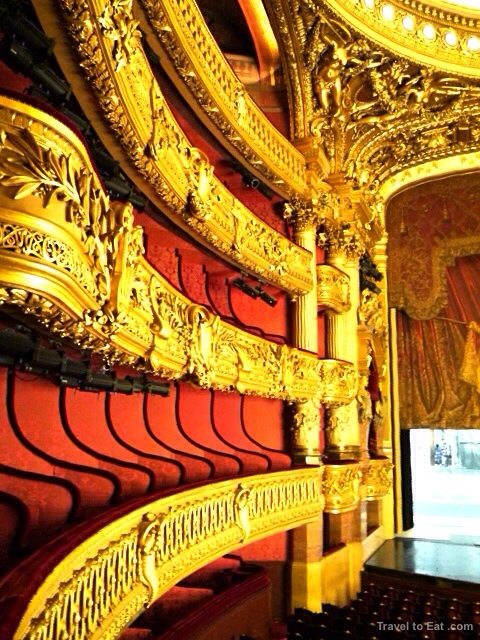
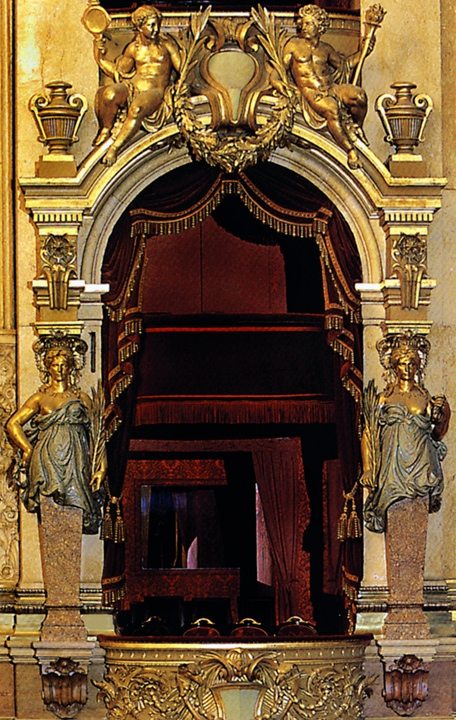
The rest of the house is just as beautiful, with lots of gilded baroque balustrades. Look carefully to the right of the picture above and you can see the painted house curtain, imitating a draped curtain with gold braid and pompons. The Opéra’s Auditorium seats about 2,000 people. Four tiers of balconies surround the ground floor, culminating in elaborate forward boxes to the left and right of the stage, with their sculptured caryatids by Gustave-Adolphe-Désiré Crauk and Alfred Édouard Lepère.
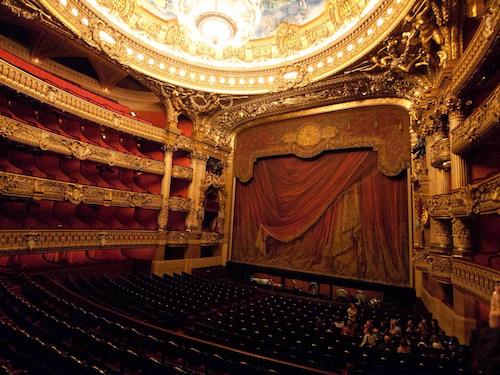
Here is another view with curtain down and the chandelier up.
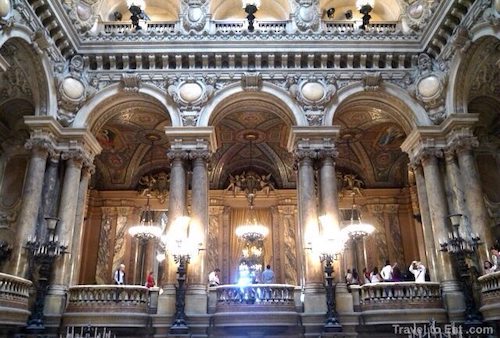
In the photo above, you can see an area just outside the Grand Foyer, the Avant Foyer, with beautiful mosaic ceilings. This and the Grand foyer were meant to be areas for socializing before the opera and at intermissions.
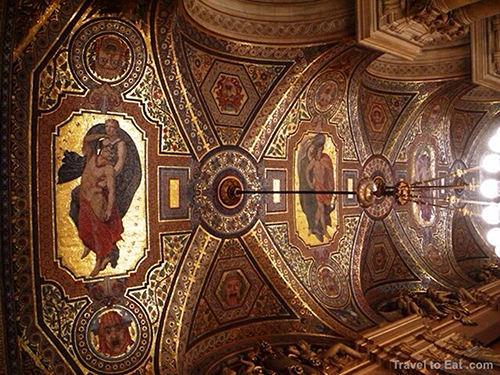
They are done in intricate mosaics performed by Venetian mosaicists. The pictures are famous couples from Greek mythology. Each story has been immortalized in different operas.
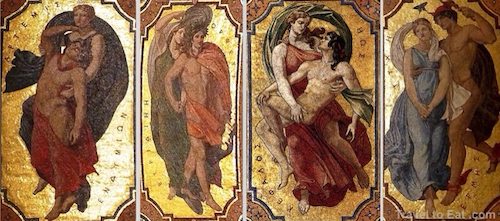
They are, from left to right, Artemus and Endymion, Orpheus and Eurydice, Aurora and Cephalus and Hermes and Herse. As you can see above, they are presented on gilded mosaic backgrounds, I will try to do a post on the four famous Greek romances in the future. Wikipedia has an extensive list of operas based on Greco-Roman mythology, more popular in the 19th century than today but still an important theme.

The Avant Foyer reflects Garnier’s passionate interest in mosaic. An inscription in the ceiling (seen above) states: “Decorative mosaic has been applied for the first time in France for the ornamentation of this vault and the popularization of this art.”

He abandoned his initial idea to decorate the Opera Auditorium ceiling in mosaic as too costly, but he used mosaic here, on the flytower “ox-eye” and the ceiling of the Facade Loggia (outdoors).
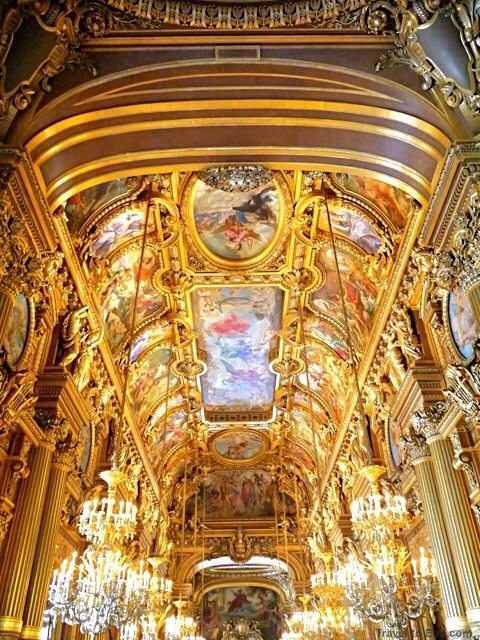
As you enter the doors of the Avant foyer, you are confronted by the Grand Foyer. Garnier intended the Grand Foyer, restored in 2004, to resemble the gallery of a classical chateau. The mirrors and windows accentuate it's vast dimensions. The ceiling and small oval paintings above the doors, painted by Paul Baudry, portray themes from the history of music. I have been to Versailles and personally, this knocks the socks off of the “Hall of Mirrors”.

The Grand Foyer comprised the largest and most complex decorative program in the Opéra’s interior. Like the rest of the Opéra, it is Garnier’s personal synthesis of all past styles. The walls are alive with gleaming, gold ornamental sculpture and the flat ceiling contains a large, rectangular panel flanked by oval panels at each end. These are surrounded by a cove containing twenty irregularly shaped panels, nine on the sides and one on each end. On the walls beneath, above each of the ten doorways, are painted oval medallions personifying the music of various countries and ethnic groups. Atop each of the twenty columns between the ten doors, separating the medallions, are sculptured figures personifying The Qualities Required by Artists. (picture courtesy of The Paris Opéra: Charles Garnier’s Opulent Architectural Masterpiece by Stephen Gjertson)
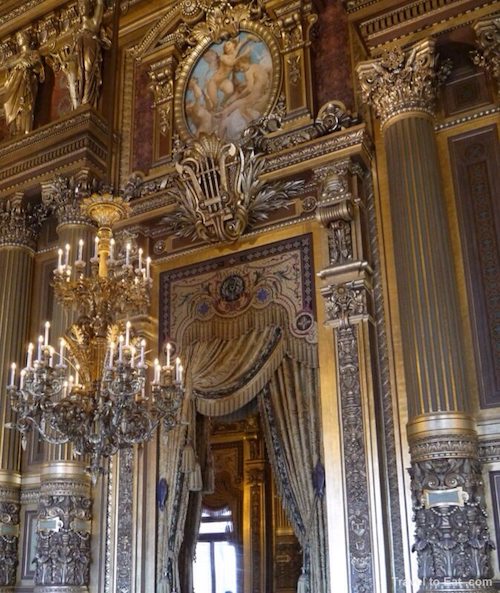
The lyre, the dominant decorative element is found just about everywhere you look. In this picture you can see the mirrored “door/window” with the Lyre above and above that the ovals painted by Paul Baudry. The often overlooked medallions, seen above the “door” are delightful, beautifully designed ovals of nude genii against and azure sky.
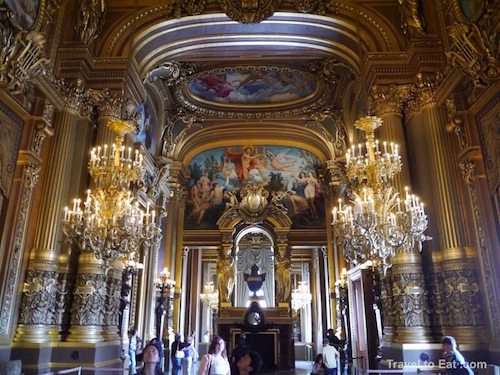
The two Octagonal Salons flank the Grand Foyer, extending and animating the effect of the larger room. Jules-Élie Delaunay decorated the east Octagonal Salon, shown above, “Apollo Receiving the Lyre”.
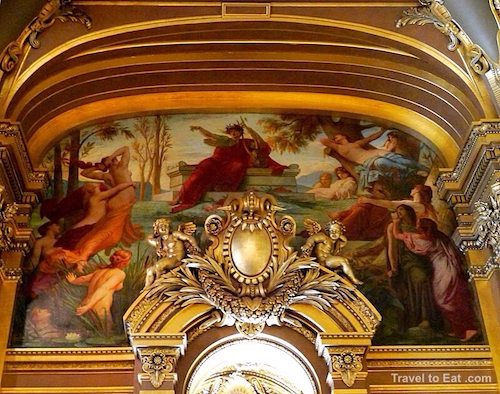
The west end was done by Joseph Barrias, this painting in the alcove, “The Glorification of Harmony” (I think), you again see the lyre in the central figure.

In the center of the room is a bust of Garnier with this inscription on the base.
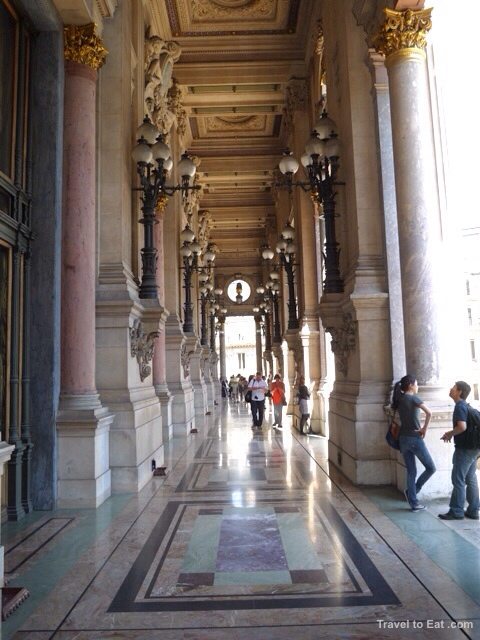
As you leave the Grand Salon, you go outside to the Facade Loggia as seen above. What a fabulous space to get some fresh air and mingle at intermission. Look at the incredible range of marble used on this veranda and the proportions. You have the feeling of being outdoors, yet enveloped by an intimate luxury. The high ceilings, the width of the loggia, ceiling capped with mosaic, the different marbles, the lamps and sculptures all contribute to this feeling. There were a lot of people on the loggia when we visited, but it wasn't hard to find a quiet place to express our amazement of the building. Everything seemed to just flow, and you had the comfortable feeling you could get used to this.
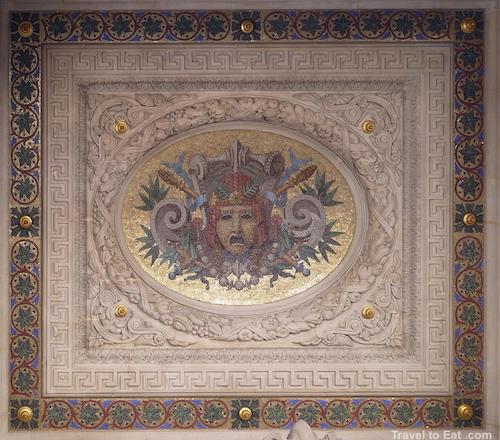
As we mentioned before, more Venetian mosaic ceilings on the loggia.

As you re-enter the building, you pass through this massive door to the Auditorium topped with a lyre.
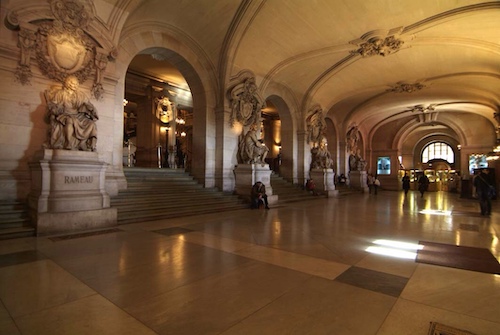
As we left we went through the Grand Vestibule, backwards from the way the opera was meant to function. Between the columns on the walls of The Grand Vestibule (the entrance in use today) are full-length, seated sculptures in marble of Gluck, Handel, Rameau and Lulli. In the old ticket office is a gift shop.
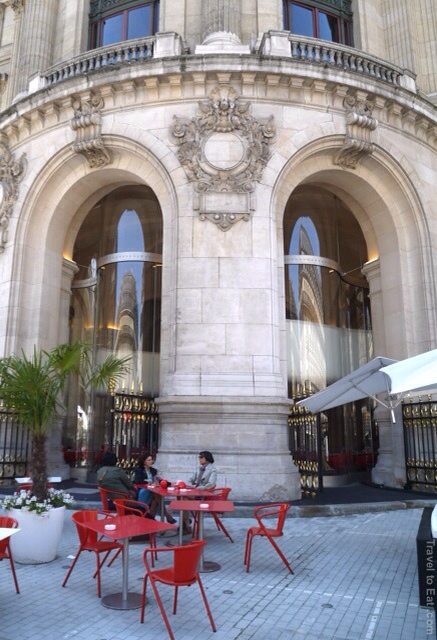
As you leave you walk past a very pretty restaurant, in which Lisa and I had drinks, outside in the Martini Bar. After three attempts since 1875, a restaurant opened its doors on the eastern facade of the building in 2011. It was designed by French architect Odile Decq. The chef is Christophe Aribert.
As Stephen Gjertson so beautifully summarizes the Palais Garnier:
“Garnier believed that architectural technology was the scientific means to an artistic end. The artistic end was the impression the architectural ensemble made on the hearts and minds of the cultured audience for whom it was created. In the interest of art he methodically concealed the technology behind a magnificent veil of fine limestone, multi-colored marble, gilded stucco and bronze, colorful mosaics, rich tapestries and sumptuous paintings. His conception of art and architecture as collaborators creating a unified and harmonious whole was triumphantly achieved in the Opéra. It took fourteen years of Garnier’s life to complete. Paul Baudry spent ten years preparing for and executing his decorations in the Grand Foyer. The result was one of the most beautiful buildings created in the 19th century, a lasting tribute to the incomparably rich and varied Beaux-Arts tradition and a theater worthy of the city to which it belonged.”
A great reference for the Opera is: The Paris Opéra: Charles Garnier’s Opulent Architectural Masterpiece by Stephen Gjertson.

